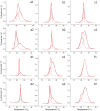Encrypted Antimicrobial Peptides from Plant Proteins
- PMID: 29038449
- PMCID: PMC5643462
- DOI: 10.1038/s41598-017-13685-6
Encrypted Antimicrobial Peptides from Plant Proteins
Abstract
Examples of bioactive peptides derived from internal sequences of proteins are known for decades. The great majority of these findings appear to be fortuitous rather than the result of a deliberate and methodological-based enterprise. In the present work, we describe the identification and the biological activities of novel antimicrobial peptides unveiled as internal fragments of various plant proteins founded on our hypothesis-driven search strategy. All putative encrypted antimicrobial peptides were selected based upon their physicochemical properties that were iteratively selected by an in-house computer program named Kamal. The selected peptides were chemically synthesized and evaluated for their interaction with model membranes. Sixteen of these peptides showed antimicrobial activity against human and/or plant pathogens, some with a wide spectrum of activity presenting similar or superior inhibition efficacy when compared to classical antimicrobial peptides (AMPs). These original and previously unforeseen molecules constitute a broader and undisputable set of evidences produced by our group that illustrate how the intragenic concept is a workable reality and should be carefully explored not only for microbicidal agents but also for many other biological functions.
Conflict of interest statement
The authors declare that they have no competing interests.
Figures





Similar articles
-
Alpha-helical cationic antimicrobial peptides: relationships of structure and function.Protein Cell. 2010 Feb;1(2):143-52. doi: 10.1007/s13238-010-0004-3. Epub 2010 Feb 6. Protein Cell. 2010. PMID: 21203984 Free PMC article. Review.
-
Rational design of HJH antimicrobial peptides to improve antimicrobial activity.Bioorg Med Chem Lett. 2023 Mar 1;83:129176. doi: 10.1016/j.bmcl.2023.129176. Epub 2023 Feb 8. Bioorg Med Chem Lett. 2023. PMID: 36764469
-
Plant antimicrobial peptides.Folia Microbiol (Praha). 2014 May;59(3):181-96. doi: 10.1007/s12223-013-0280-4. Epub 2013 Oct 4. Folia Microbiol (Praha). 2014. PMID: 24092498 Free PMC article. Review.
-
Current synthetic chemistry towards cyclic antimicrobial peptides.J Pept Sci. 2022 Jun;28(6):e3387. doi: 10.1002/psc.3387. Epub 2021 Dec 21. J Pept Sci. 2022. PMID: 34931393 Review.
-
Antimicrobial peptides designed by computational analysis of proteomes.Antonie Van Leeuwenhoek. 2024 Mar 15;117(1):55. doi: 10.1007/s10482-024-01946-0. Antonie Van Leeuwenhoek. 2024. PMID: 38488950
Cited by
-
Plant Antimicrobial Peptides (PAMPs): Features, Applications, Production, Expression, and Challenges.Molecules. 2022 Jun 9;27(12):3703. doi: 10.3390/molecules27123703. Molecules. 2022. PMID: 35744828 Free PMC article. Review.
-
Towards an experimental classification system for membrane active peptides.Sci Rep. 2018 Jan 19;8(1):1194. doi: 10.1038/s41598-018-19566-w. Sci Rep. 2018. PMID: 29352252 Free PMC article.
-
Antimicrobial and Cell-Penetrating Peptides: Understanding Penetration for the Design of Novel Conjugate Antibiotics.Antibiotics (Basel). 2022 Nov 16;11(11):1636. doi: 10.3390/antibiotics11111636. Antibiotics (Basel). 2022. PMID: 36421280 Free PMC article. Review.
-
Secretory Peptides as Bullets: Effector Peptides from Pathogens against Antimicrobial Peptides from Soybean.Int J Mol Sci. 2020 Dec 5;21(23):9294. doi: 10.3390/ijms21239294. Int J Mol Sci. 2020. PMID: 33291499 Free PMC article. Review.
-
The Role of Peptide Signals Hidden in the Structure of Functional Proteins in Plant Immune Responses.Int J Mol Sci. 2019 Sep 5;20(18):4343. doi: 10.3390/ijms20184343. Int J Mol Sci. 2019. PMID: 31491850 Free PMC article. Review.
References
-
- Lemaître G. Un Univers homogène de masse constante et de rayon croissant rendant compte de la vitesse radiale des nébuleuses extra-galactiques. Ann. la Société Sci. Bruxelles. 1927;47:49–59.
-
- Lemaître G. The Beginning of the World from the Point of View of Quantum Theory. Nature. 1931;127:706–706. doi: 10.1038/127706b0. - DOI
-
- Kragh HS, Lambert D. The Context of Discovery: Lemaître and the Origin of the Primeval-Atom Universe. Ann. Sci. 2007;64:445–470. doi: 10.1080/00033790701317692. - DOI
Publication types
MeSH terms
Substances
LinkOut - more resources
Full Text Sources
Other Literature Sources
Medical

